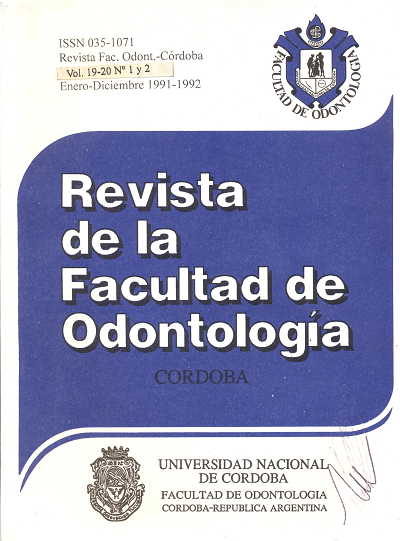Desgaste oclusal de las resinas compuestas estudio clínico cuantitativo de las resinas compuestas fotopolimrerizables en elementos posteriores
Keywords:
Dental Occlusion, Case Studies, Resin CementsAbstract
In spite of many achievements concerning resin properties, the ideal material to solve definitely clínica! problems such as the loss of sustance in the occlusal surface hasn 't still been found. This study !asted eighteen months and aimed to determine the clinical and quantitative occlusal wasting of three photopolymerizable composite resins in the posterior sector of the mouth. Ten patients ages ranging 25 +/- 3 years were selected, In each patient three simple occlusal cavities were performed in molars, and premolars, according to the direction of the adamantine prisma. Cavities were obturated by incresing Techniques and using the resins Heliomolar, Herculite and Visiomolar. Models of the occlusal surface were taken by using Optosil XantoprenDensita bounden technique. The loss of substance was evaluated by photomicrographies and the areas of occlusal wasting were measured with a polar planimeter (Milux 5296) after 6,12 and 18 months. For statistical measurements the Anova table was used. There were not significant differences in wasting produced in the different resins used; either between the two kinds of theeth we worked on. There was lose of material only as time went by. Results showed the Visiomolar was the material suffering less loss of substance during the 18 months study; the greatest loss with Herculite was al 12 months after application and Heliomolar suffered the greatest loss of substance in 18 months. In all cases the process was slow and more remarkable in molars than in premolars.
Downloads
Downloads
Published
Issue
Section
License
Aquellos autores/as que tengan publicaciones con esta revista, aceptan los términos siguientes:
- Los autores/as conservarán sus derechos de autor y garantizarán a la revista el derecho de primera publicación de su obra, el cuál estará simultáneamente sujeto a la Licencia de reconocimiento de Creative Commons que permite a terceros:
- Compartir — copiar y redistribuir el material en cualquier medio o formato
- La licenciante no puede revocar estas libertades en tanto usted siga los términos de la licencia
- Los autores/as podrán adoptar otros acuerdos de licencia no exclusiva de distribución de la versión de la obra publicada (p. ej.: depositarla en un archivo telemático institucional o publicarla en un volumen monográfico) siempre que se indique la publicación inicial en esta revista.
- Se permite y recomienda a los autores/as difundir su obra a través de Internet (p. ej.: en archivos telemáticos institucionales o en su página web) después del su publicación en la revista, lo cual puede producir intercambios interesantes y aumentar las citas de la obra publicada. (Véase El efecto del acceso abierto).

